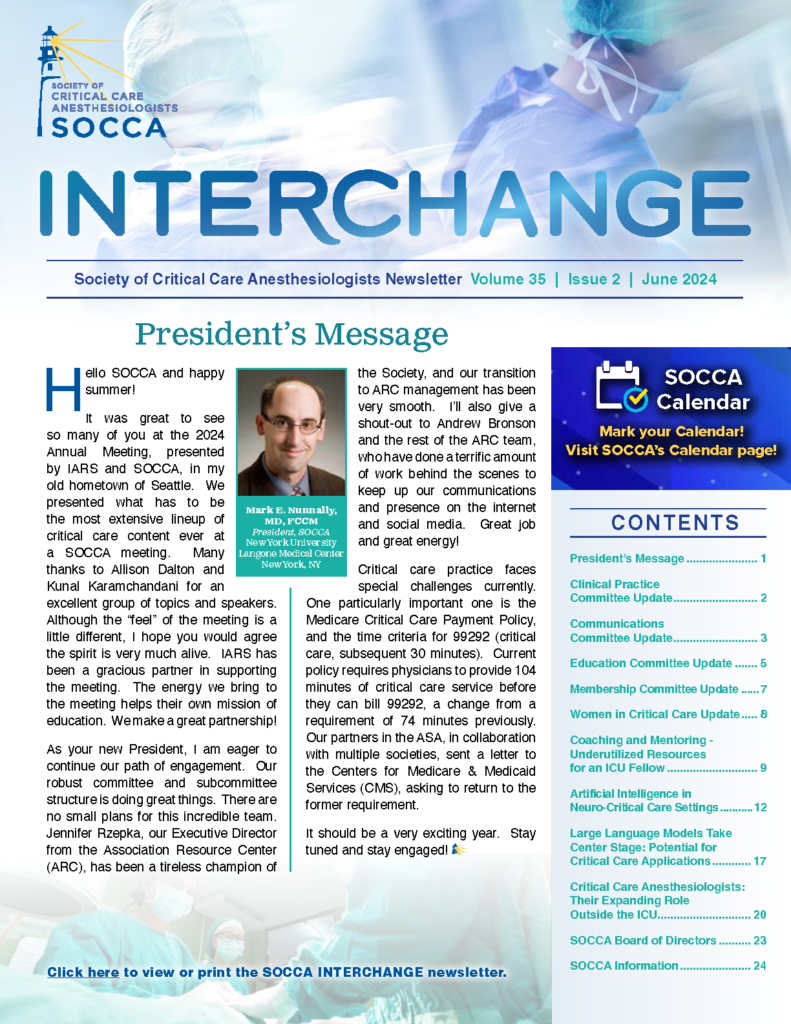Women in Critical Care: Suggestions to Organizations/ Societies for Female Representation in Critical Care
Disclaimer: This is a work product of Women in Critical Care and does not represent the views of the Society of Critical Care Anesthesiologists
Background: Despite the increasing percentage of female intensivists and their multifaceted involvement in healthcare over the last decades, to date, their representation in physician workforce, academic positions and leadership roles in critical care remains disproportionately low.
Similar to their male counterparts, female intensivists dedicate themselves to long-term learning, rigorous training, and high-intensity work and are able to gather equal qualifications and experiences. However, it has become globally recognized that this effort does not necessarily translate to equal career opportunities across all levels of the professional ladder, or to comparable academic or professional metrics, including academic rank, leadership positions, publications, funding, and other scholarly ventures. As compared to their male counterparts, women intensivists are paid less, and many have experienced harassment at work. (AAMC 2022)
There are many striking examples of this gender imbalance in critical care. This bias also affects likelihood of research funding, as a Swedish study found that women needed to have 2.5 times the publications to have the same peer-review score for submitted research grants. Literature also shows a dearth of first and senior authorship from women published in contemporary high and medium impact critical care journals. This gender imbalance disrupts individual professional growth, but also has a negative impact on working dynamics, efficiency and productivity, motivation and confidence, mental health, and quality of life.
Deciphering the underlying causes of this phenomenon is challenging, but there are likely contributing factors. Women mostly confront greater and more time-consuming challenges with regards to childbearing and family responsibilities that are compounded by sociocultural expectations and stereotypes. Furthermore, studies done in other related fields point to working environments being inhospitable due to unequal payment, unsatisfactory working conditions, work-related stress from biased perceptions, and unfavorable policies for women. Lastly, networking seems to also remain challenging for women.
As a society, we definitely are in a better place than we used to be. Awareness about gender equality has been raised but gender equity has still to be reached. The critical care field is not different. Women in Critical Care strongly believe in meritocracy. However, in order to achieve meritocracy and fair treatment, regardless of gender, we have to establish equal “enablers” for both male and female intensivists.
Recruitment, rewards, promotions, leadership roles and participation in committees and scientific events must be advocated for those who deserve them, those who have demonstrated the scientific merits and abilities, regardless of gender. We, as women, do not want to be chosen just because we are women. We want to be chosen for our work, our outcomes, our vision, our ethos. In order to reach this state, we need a cultural change at an individual, institutional and societal level. The leading societies and organizations in our field can play a critical role towards that transformation.
To reach that goal, WICC recommends the following suggestions which professional societies of intensive care and organizations can espouse to empower more women to enter and thrive in CCM:
Considerations for Professional Societies
-Review of women’s current and historical representation in leadership to inform future policies
-Consider the establishment of CME programs to highlight unconscious bias and harassment, especially among recruitment/ program directors, academic promoters, event organizers
-Comprehensive review of policies and practices to identify and extinguish contributors to imbalance in operations and leadership in committees, chair sessions, panels, editorial boards, lectures, and workshops
Considerations for Organizations
-Ensure that recruitment, rewards, and promotions are designed in ways that minimize any potential gender bias
-Include women and URMs (underrepresented minorities) in selection committees
-Develop expertise, and sponsorship, mentorship and coaching around women in academics
-Encourage women to apply for potential leadership positions and work with them to make it possible to lead whilst fulfilling other roles at home and in practice, including the possibility of flexible scheduling
-In-depth review of existing policies and advocacy for practices that promote the concept of shared parenthood and family care roles (e.g., mandatory paternity leave)
-Develop and endorse policy statements for issues affecting women in CCM (e.g. lactation, infertility, pay negotiations, psychological, sexual and physical safety at work)
Major professional societies and organizations have the obligation to initiate and sustain this cultural change by implementing strategies that support and enhance gender equality in critical care. WICC invites members of SOCCA to opine and add to these suggestions. Understanding and recognizing gender diversity challenges and carrying on the momentum started within the past few years within SOCCA and outside it, will enable a positive environment for more women to enter and remain within ACCM.



































